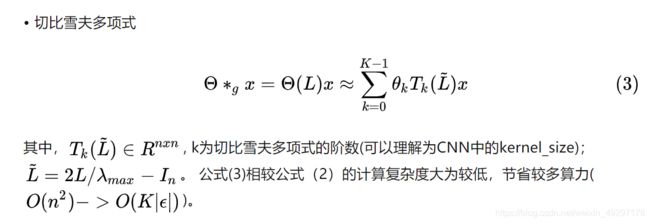STGCN复现第三弹:解读math_graph.py
scaled_laplacian函数:
def scaled_laplacian(W):
'''
Normalized graph Laplacian function. 标准化拉普拉斯矩阵
:param W: np.ndarray, [n_route, n_route], weighted adjacency matrix of G.
:return: np.matrix, [n_route, n_route].
'''
# d -> diagonal degree matrix 度矩阵
n, d = np.shape(W)[0], np.sum(W, axis=1) #1.取出矩阵W的维度 2.将矩阵W的列向量相加
’‘’
举例:
c = np.array([[0, 2, 1], [3, 5, 6], [0, 1, 1]])
print c.sum()
print c.sum(axis=0)
print c.sum(axis=1)
结果分别是:19, [3 8 8], [ 3 14 2]
‘’‘
# L -> graph Laplacian
L = -W
L[np.diag_indices_from(L)] = d #返回索引以访问n维数组L的主对角线
for i in range(n):
for j in range(n):
if (d[i] > 0) and (d[j] > 0):
L[i, j] = L[i, j] / np.sqrt(d[i] * d[j])
# lambda_max \approx(大约) 2.0, the largest eigenvalues(特征值) of L.
lambda_max = eigs(L, k=1, which='LR')[0][0].real # 1. k:int, 可选参数所需的特征值和特征向量的数量。 2.‘LR’:largest real part 3. x.real取得xd的实部
#eigs()全称为scipy.sparse.linalg.eigs()用于求平方矩阵A的k个特征值和特征向量。
return np.mat(2 * L / lambda_max - np.identity(n)) #np.identity(n)生成一个n行n列的单位矩阵
np.identity()函数详解
scipy.sparse.linalg.eigs()函数详解~
cheb_poly_approx函数:
def cheb_poly_approx(L, Ks, n):
'''
Chebyshev(切比雪夫) polynomials(多项式) approximation(逼近、近似) function.
:param L: np.matrix, [n_route, n_route], graph Laplacian(拉普拉斯算子).
:param Ks: int, kernel size of spatial convolution(空间卷积核大小).
:param n: int, number of routes / size of graph.(图的大小)
:return: np.ndarray, [n_route, Ks*n_route]. 返回一个np.ndarray的多维数组
'''
L0, L1 = np.mat(np.identity(n)), np.mat(np.copy(L)) #np.copy():返回给定对象的数组副本
if Ks > 1:
L_list = [np.copy(L0), np.copy(L1)]
for i in range(Ks - 2):
Ln = np.mat(2 * L * L1 - L0)
L_list.append(np.copy(Ln))
L0, L1 = np.matrix(np.copy(L1)), np.matrix(np.copy(Ln))
# L_lsit [Ks, n*n], Lk [n, Ks*n]
return np.concatenate(L_list, axis=-1)
elif Ks == 1:
return np.asarray(L0) #将输入转换为数组
else:
raise ValueError(f'ERROR: the size of spatial kernel must be greater than 1, but received "{Ks}".')
np.copy()函数详解
np.concatenate()函数详解
numpy.asarray()函数详解


